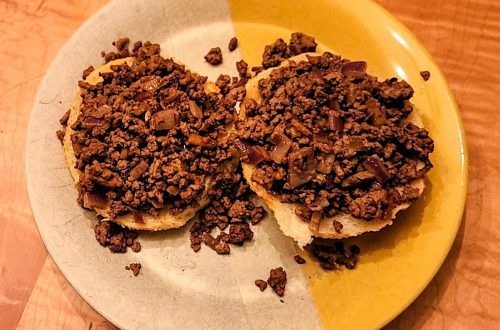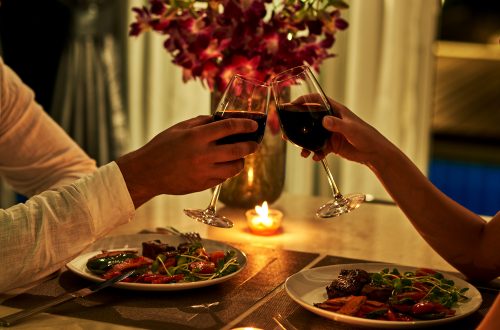
Waking Up to Breakfast
From your email, please click on the title to view the photos and comment online. On the Website, you can read past blogs, search for recipes, and browse.
Breakfast, to me, has always been one of those curious meals – not a really serious time to sit down to eat. You might think that, growing up on a farm, I’d lean toward a big breakfast of eggs, bacon, toast, pancakes, syrup, and OJ. Nope. Actually, when I was a kid, I usually began the day with toast and milk before climbing onto the bus for the ride to school. On occasions when I stayed overnight with my grandparents, my grandmother would have a big bowl of oatmeal ready for me early in the morning – simple as that.
These days, it’s a corn muffin, or cold cereal, or a slice of buttermilk raspberry cake (if I’m lucky). Maybe oatmeal (if I feel like making it), together with a glass of milk and a cup of coffee while reading the morning paper. Meanwhile, Mrs. Farmboy has recently switched from eating yogurt and fruit to shredded wheat or Kashi and milk, mainly because yogurt only comes in plastic cartons. And now she says she prefers cereal anyway – which comes in paper, not plastic.
As for the rest of America, some 40 percent of adults skip breakfast. Seniors, however, are far more likely to eat a morning meal – 83 percent of them, in fact – probably because they have more time. About a third of breakfast-eaters in general go for cold cereal, which explains the plethora of brands at the supermarket. Of the rest, 20 percent eat eggs, while one in 10 eats a bagel, toast, muffins, or a pastry. And among my friends, there are those who enjoy hot cereal – grits, Cream of Wheat, or Wheatena.
What the rest of the world eats
I researched other breakfast traditions around the world and wasn’t surprised to find that breakfast cereal isn’t universal. In Japan, it’s miso soup and rice, maybe with a piece of salmon. Aussies are likely to coat their toast with vegemite, a concoction made from leftover brewing yeast. In Mexico, you may get to taste menudo, a tripe soup made with spices and chili peppers. The Dutch decorate their buttered morning toast with hagelslag, high-quality chocolate sprinkles. In Peru, you might find leche de tigre, a glass full of liquid made from fish juice, lime, onion, salt, pepper, and a generous amount of hot pepper.
When I’m traveling outside the U.S. and eating breakfast at a restaurant or hotel, I don’t think I’ve ever seen any cereal more exotic than cornflakes, which might be offered largely in deference to American guests. When visiting the U.K., I enjoy the full English breakfast (Pictured above) — eggs, sausages, fried potatoes, broiled tomatoes, toast, and baked beans. In Germany, I enjoy the frühstück buffet table laden with whole-grain breads and rolls with a variety of cold meats, sausages, and cheese, together with seasonal fruits. I tend to eat a big breakfast before spending the day seeing the sights.
So what’s up with the cold cereal here in the U.S.? Well, we can thank the brothers Kellogg, who invented corn flakes to sell in their Seventh Day Adventist health spa in Battle Creek, Michigan back in the 1890s. (You can read all about it in T.C. Boyle’s novel The Road to Wellness.) Back then, they were trying to cure “dyspepsia” brought about by the then-prevalent consumption of steak and eggs – among the privileged classes, of course – for the first meal of the day.
What the rest of the world used to eat
What about nutrition and the whole debate about getting adequate nutrition to start your day? It seems that the “study” discussions are often disguised as marketing campaigns aimed at selling cereal, orange juice, or Pop Tarts. In fact, Europeans in the Middle Ages eschewed breakfast, and Thomas Aquinas asserted that eating early in the morning put individuals on the road to the deadly sin of gluttony.
Consider that the word “dinner” came from the Gallo-Roman desjunare, which meant “to break the fast,” and “breakfast” has a more literal etymology. At that historical juncture, the morning meal was called morgenmete. Ancient Egyptians ate a single daily meal, most likely in the morning, that consisted of soup, beer, bread, onions, and felafel. Greeks consumed barley bread dipped in wine, sometimes with figs or olives and sometimes with pancakes. Romans breakfasted on everyday staples like bread, cheese, olives, salad, nuts, raisins, and cold meat leftovers, washing it down with a mixture of wine, honey, and spices.
What about nutritional science?
In any case, the majority of arguments in favor of the morning meal have to do with the need to fuel up before setting out for the morning’s labors, and science does agree on the importance of morning nutrition for children. But for adults, there doesn’t seem to be a compelling reason to eat breakfast except if you’re hungry.
In an article in Harvard Health Publishing, Dr. Monique Tello says we all should be eating fruits and vegetables for breakfast. She recommends a quick meal that incorporates berries or mixed fruit together with grains and nuts – a sort of low-sugar granola. As for my breakfasts, well, turns out that eating all those processed carbs and sugars in the morning causes your blood sugar and insulin levels to rise. Guess we’re better off with the fruit and yogurt combo after all.
What do you eat for breakfast? And how has that changed over the years?
Please click on the headline to view the blog on the website. You can log in and comment at the end of the blog to share your thoughts and start a discussion, or suggest a topic for Farmboy in the Kitchen.
If you’d like to share the blog, click on the Facebook icon or one of the others. Thanks!





2 Comments
Mercy
Thank you Mr. Farmboy for such a great article on breakfast and especially the historical part. One might then conclude that our choices for breakfast were determined by what was available. My Kenyan grandparents always had a sweet potato or taro ( a starchy arrow root) with tea for breakfast, enough carbs for an all day work at the farm;cereal is not real food to them. I often do have the same breakfast as my grandparents with an egg added to the menu and I switch it up with rolled oats. Keeping it natural is way healthier than flowing with modernization of having cereal for breakfast( I don’t mean to ruin it for Mrs Farmboy). I have to believe that I see it that way because of my upbringing and so are many others. I also think it’s universal that breakfast all day is a treat!
Cheers.
Farmboy
Mercy,
It’s so good to hear from you. I really appreciate your comment. I bet that breakfast is delicious, though I can’t imagine that taro was that tasty. I’ve tasted it in Hawaii, and the flavor reminded me of the old paste we used in grade school. I also must admit that I just a fair amount of brown sugar when I have my oatmeal. But breakfast almost always lasts me until dinner.
Please keep the comments coming.
Farmboy